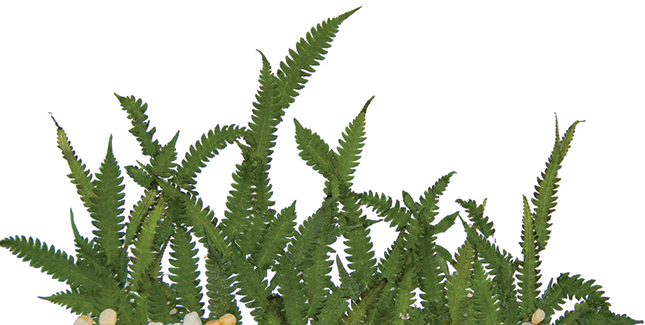The Maven: Rethinking Your Turf
In the 1700s European aristocrats invented a new landscaping feature: the lawn. Intended as a status symbol, lawns leapt across the ocean to estates in America, then spread throughout the country with the rise of the suburbs. Today lawns are a staple of our suburban scenery.
In the eastern states, lawns slurp up one-third of household water use, according to Columbia University’s Earth Institute.
Janette Rosenbaum ’07
But all of that green grass comes with a cost. In the eastern states, lawns slurp up one-third of household water use, according to Columbia University’s Earth Institute. In the West, that number can reach as high as 60 percent. Lawn mowers and other yard equipment are estimated to produce “up to 5 percent of the nation’s air pollution and a good deal more in metropolitan areas,” according to the US Environmental Protection Agency. This pollution includes greenhouse gases that contribute to climate change. Fertilizers and pesticides, commonly used on domestic lawns, are known to have toxic effects on humans and wildlife. And, while our groomed greenery may give us a sense of pride, numerous studies have found that being in the presence of naturally growing plants has health benefits—including a boost to memory and attention, relief from stress, and faster recovery from illness—that far outlast a perfect outdoor carpet.
Go bold
Despite the negative effects of maintaining a pristine lawn, some aren’t ready to cede their turf. They want a place for the kids to play, or they may fear conflict with lawn-loving neighbors. Not to worry: there are plenty of ways to reduce the environmental impact of your yard without giving up the grass.
- Let it go brown in August. Summer dormancy is a natural, healthy state for lawn grasses. You’ll conserve water and reduce the need for mowing.
- Ditch pesticides. The vast majority of insects are harmless to us, our pets, and our favorite plants. Many pesticides, on the other hand, are carcinogenic.
- Eschew commercial fertilizers. Grass clippings, left on the lawn, make a great natural fertilizer. So do fall leaves and composted kitchen scraps.
- Shrink your mower. Trade in your ride-on for a gas-powered walk-behind, gas for electric, or electric for manual. The smaller the mower, the less pollution it makes—and the lower the risk of injury.
Go small
If you’re ready to go further, consider shrinking the lawn itself. Replace traditional lawn grasses in low-traffic areas with “low-mow,” “no-mow,” or “eco” grass mixes, which need minimal maintenance. Or, turn a section of lawn into a vegetable bed or native plant garden. Organic, homegrown veggies are healthier and cheaper than what’s available at the supermarket, and native plants require minimal maintenance and provide vital habitats for local animals.
Go natural
In most countries outside the United States, sprawling lawns have never been the norm. Instead, most people enjoy cozy gardens full of flowers or vegetables. While some appreciate having an open lawn for hosting summer barbecues or impromptu soccer games, many of us could get more use out of our yards by growing our own food or encouraging birds to enliven our space. With simple changes, all of us can spend less time mowing our lawns and more time enjoying healthier, safer, quieter neighborhoods.
 Janette Rosenbaum ’07 is a master’s student in environmental studies at the University of Wisconsin-Madison. She is writing a thesis on the history of lawns and their environmental impacts. Her quarter-acre yard in Madison has hosted more than fifty species of birds and produces no waste. She writes about sustainable gardening at whatsinthatyard.wordpress.com.
Janette Rosenbaum ’07 is a master’s student in environmental studies at the University of Wisconsin-Madison. She is writing a thesis on the history of lawns and their environmental impacts. Her quarter-acre yard in Madison has hosted more than fifty species of birds and produces no waste. She writes about sustainable gardening at whatsinthatyard.wordpress.com.
This article appeared in the spring 2017 issue of the Alumnae Quarterly.
April 7, 2017











Janette: I’m in Michigan, with more than half an acre of space around the house. Most of the back is forested producing lots of shade. Portions adjacent to the woods that used to be grass have become quite wet/muddy. Is there anything that I can put in these very wet areas that will be earth friendly and low maintenance?
Hi Mona: Yes! There are two things you can do.
First, investigate why this spot has gotten so wet. You may be able to redirect downspouts or build swales (shallow drainage channels) to spread the water out and prevent it from collecting in a single soggy area.
Second, there are plenty of plants that like a wet, shady spot. Find a native plant expert or other resource in your area, and ask which species are suited to these conditions. There are definitely plants that would love to live in your yard, turning your excess water into flowers and wildlife food! Once established, they’ll do their job with little to no maintenance.
Happy gardening!
Great article! May I have your permission to share it with the Canandaigua Botanical Society? Either on our website, facebook, or both?
Yes, please share! Thank you for reading and for asking.